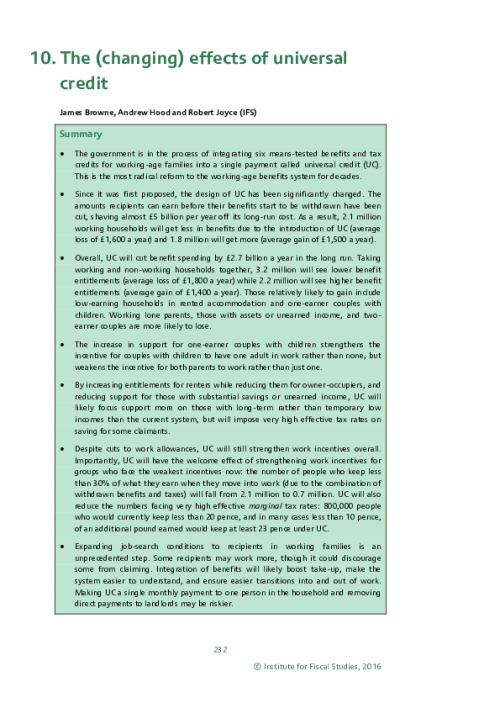Over the course of this parliament, the government is rolling out the most radical reform to the working-age benefits system for decades. A single means-tested payment, known as universal credit (UC), is being introduced as a replacement for six existing means-tested benefits and tax credits for those of working age: income support, income-based jobseeker’s allowance, income-based employment and support allowance, child tax credit, working tax credit and housing benefit.
The ‘legacy’ system that UC will replace is largely the product of a history of separate decisions to layer new strands of support on top of what came before: for example, the decisions in the 1970s to create a national system of housing benefit and a new form of support for low-income working families. Previous social security reforms, including the Fowler reforms of the late 1980s and the introduction of the current tax credit system in 2003, stopped far short of the ambitious integration of benefits that UC will bring about. The central point of UC, and the reason for many of its potential advantages, is that it replaces the resulting jumble of separate and overlapping means tests with one integrated assessment of families’ entitlements. UC should look more like a system that has been designed from scratch as a coherent whole – as indeed it is.
Unsurprisingly with such a radical structural overhaul, its impacts on the incomes and incentives of different households are complicated. They depend on the precise combination of benefit entitlements that a household has under the legacy system – the product of multiple separate benefit entitlement calculations – which in turn depends on a wide array of household characteristics. The impacts also depend, of course, on the structure of UC that the government chooses. That plan has changed significantly since the idea of UC was first set out. In particular, the so-called ‘work allowances’ – the amounts working families can earn before UC starts to be withdrawn – have been repeatedly reduced relative to the initial UC proposal, significantly cutting the amount of support that UC will give to low-income working families.
The main purpose of this chapter is to set out the impacts on incomes and incentives of introducing UC, given the current (substantially revised) plans for how UC will look. We also review some of the other very important changes that will be associated with the introduction of UC, such as the regime of conditionality, and discuss its potential effects on behaviour, such as labour supply and take-up of benefits.
This chapter of the IFS Green Budget 2016 covers the following points:
- The government is in the process of integrating six means-tested benefits and tax credits for working-age families into a single payment called universal credit (UC). This is the most radical reform to the working-age benefits system for decades.
- Since it was first proposed, the design of UC has been significantly changed. The amounts recipients can earn before their benefits start to be withdrawn have been cut, shaving almost £5 billion per year off its long-run cost. As a result, 2.1 million working households will get less in benefits due to the introduction of UC (average loss of £1,600 a year) and 1.8 million will get more (average gain of £1,500 a year).
- Overall, UC will cut benefit spending by £2.7 billion a year in the long run. Taking working and non-working households together, 3.2 million will see lower benefit entitlements (average loss of £1,800 a year) while 2.2 million will see higher benefit entitlements (average gain of £1,400 a year). Those relatively likely to gain include low-earning households in rented accommodation and one-earner couples with children. Working lone parents, those with assets or unearned income, and two-earner couples are more likely to lose.
- The increase in support for one-earner couples with children strengthens the incentive for couples with children to have one adult in work rather than none, but weakens the incentive for both parents to work rather than just one.
- By increasing entitlements for renters while reducing them for owner-occupiers, and reducing support for those with substantial savings or unearned income, UC will likely focus support more on those with long-term rather than temporary low incomes than the current system, but will impose very high effective tax rates on saving for some claimants.
- Despite cuts to work allowances, UC will still strengthen work incentives overall. Importantly, UC will have the welcome effect of strengthening work incentives for groups who face the weakest incentives now: the number of people who keep less than 30% of what they earn when they move into work (due to the combination of withdrawn benefits and taxes) will fall from 2.1 million to 0.7 million. UC will also reduce the numbers facing very high effective marginal tax rates: 800,000 people who would currently keep less than 20 pence, and in many cases less than 10 pence, of an additional pound earned would keep at least 23 pence under UC.
- Expanding job-search conditions to recipients in working families is an unprecedented step. Some recipients may work more, though it could discourage some from claiming. Integration of benefits will likely boost take-up, make the system easier to understand, and ensure easier transitions into and out of work. Making UC a single monthly payment to one person in the household and removing direct payments to landlords may be riskier.
This chapter was presented at the Green Budget launch on 8 February 2016. All presentations are available to view on our Youtube Green Budget 2016 playlist.










